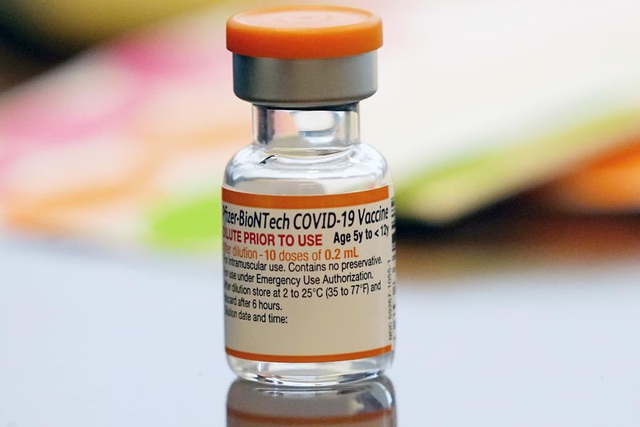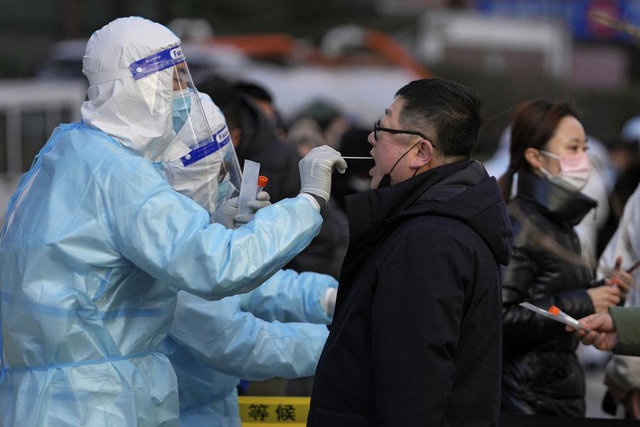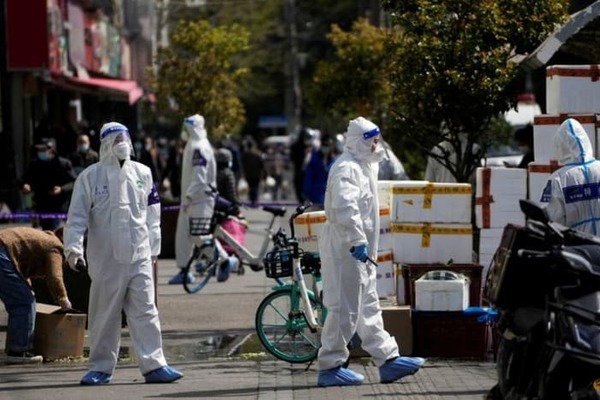The number of children infected with COVID-19 in the US increased by 72% in 2 weeks, struggling to fight the epidemic in Beijing
More than 528.58 million people around the world have contracted the SARS-CoV-2 virus. (Photo: AP)
The country most severely affected by the epidemic COVID-19, America currently recorded over 85.14 million cases and more than 1,029 million deaths. In the past day, the US recorded more than 30,000 people SARS-CoV-2 virus infection.
According to the latest report of the American Academy of Pediatrics (AAP) and the Association of Children’s Hospitals, in the past week, the US has recorded more than 107,000 cases of COVID-19 in children, an increase of 72% compared to two weeks ago. This is the sixth consecutive week that the number of children infected with COVID-19 has increased in the US. Thus, since the outbreak of the pandemic, up to now, the US has 13.3 million children positive for SARS-CoV-2 virus. Notably, out of these, 316,000 children were recorded with the disease in the past 4 weeks. Since the beginning of this year, nearly 5.4 million children in the US have contracted COVID-19.
The report also said that children account for 19% of all cases in the US. The AAP said there is an urgent need to collect more detailed age data to assess disease severity associated with new variants as well as potential long-term effects.
Doctors and scientists in the US have published the first results of research aimed at deciphering what causes some people to struggle with diabetes. persistent COVID syndrome, one of the biggest “mysteries” in the COVID-19 pandemic. As soon as the COVID-19 pandemic broke out, doctors and researchers from the National Institutes of Health (NIH) began to analyze the medical records of hundreds of patients to find out what caused these people to contract the syndrome. prolonged COVID symptoms.
Scientists have found that more than half of COVID-19 patients, even though they have tested negative for the SARS-CoV-2 virus after many months, still have symptoms of fatigue, brain fog, and headaches. , chest tightness and many other manifestations. However, they confirmed, the number of people experiencing the above symptoms does not account for 50% of the cases that have been cured. The actual number may be much lower.
At the world’s second largest COVID-19 epidemic center Indiaon May 24, the country recorded a total of over 43.14 million people with COVID-19, including 524,490 deaths from COVID-19 in this South Asian country.
Brazil currently the world’s 3rd largest epidemic hotspot with more than 665,700 COVID-19 patients out of a total of over 30.8 million infected people in this country.
Fourth nose vaccine against COVID-19 mRNA technology can help increase antibody levels and T-cell immune responses higher than the third shot. Here are trial data recently published in Brother.
The researchers conducted the trial in 166 adults who received a third dose of Pfizer-BioNTech’s mRNA vaccine after completing the primary dose of the same vaccine or AstraZeneca’s vector technology vaccine. These people were randomly selected to receive the fourth dose of Pfizer-BioNTech or Moderna (mRNA technology) vaccines. Half of the trial participants were over 70 years old, and the median time since the third injection was 7 months.
The results showed that, two weeks after the fourth injection, the antibody concentration against the spike protein of the SARS-CoV-2 virus was twice as high as the antibody concentration produced at 4 weeks after the third injection. Antibody levels after the fourth dose of Pfizer-BioNTech and Moderna vaccines were similar.
Meanwhile, the immune response from T cells increased sharply 14 days after the 4th dose of mRNA vaccine, faster than 28 days after the 3rd dose. However, this result was only recorded in volunteers. injected the first 3 doses of the vaccine of Pfizer-BioNTech and the fourth dose of the vaccine of Moderna.

Tourism industry of the Yukon Territory (Canada) is eagerly awaiting the news that for the first time since the outbreak of the COVID-19 pandemic, the country’s northernmost border will reopen on June 1. The border is a route to “family connection,” especially for the local First Nation Aboriginal community. Therefore, opening the border is also of great significance for maintaining the local culture and history.
May 24th, North Korea There were no new deaths among the fever cases, the first time since the country detected the COVID-19 outbreak nearly two weeks ago. At the same time, North Korean officials said that the number of patient cases related to the COVID-19 epidemic was on a “stable” downward trend. North Korea said it had “successful” in stopping the spread of the COVID-19 epidemic and that no new fever deaths had been reported as of May 23 evening, despite an additional 134,510 new patient.
This is the third day in a row that the daily number of fever cases has stayed below 200,000, and the first time North Korea has reported no new deaths since announcing the daily number of fever patients, according to the official news agency. KCNA.
North Korea did not confirm the total number of people who tested positive for the SARS-CoV-2 virus, instead, Pyongyang reported the number of patients with fever symptoms. Accordingly, the total number of fever cases since the end of April in the country has increased to 2.95 million, while the death toll is 68, according to KCNA.
North Korea says its authorities are distributing food and medicine across the country, with military medical forces deployed to help distribute medicine and conduct health checks. KCNA also said that North Korea is expanding the production of supplies of essential drugs, although it did not specify exactly what drugs are being produced.
Number of new COVID-19 cases recorded daily in Korea fell below 10,000 for the first time in four months. South Korea has eased the restrictive measures applied to prevent the epidemic in the context of the wave of infection of the Omicron variant gradually waning.
The Korea Centers for Disease Control and Prevention announced that the country recorded 9,975 new cases of COVID-19, the lowest level since the end of January. The number of patients with severe COVID-19 who were hospitalized for treatment also decreased to 225. This is the 5th day in a row that the number of critically ill patients in Korea has reached 200.
Since the beginning of May, South Korea has relaxed most of the measures to prevent the COVID-19 epidemic, including the mandatory wearing of masks when outdoors, in the context that the number of new cases tends to decrease.
From next June, South Korea will resume nearly 140 flights on 22 international routes. In particular, the flight route connecting the South Korean capital Seoul and the Japanese capital Tokyo is expected to resume on June 8 after more than two years of shutdown due to the pandemic. Four other airports in South Korea will also increase international flights. Of these, the airport in Busan city will resume nearly 80 international flights on 13 routes from next month, providing flight services connecting the cities of Hanoi (Vietnam), Fukuoka (Japan), and Bangkok. (Thailand), and Ulan Bator (Mongolia).
On May 24, Deputy Minister of Health Indonesia Dante Saksono Harbuwono said it will take more than 6 months to monitor the COVID-19 epidemic situation and confirm the pandemic is over in Indonesia. Speaking at a hearing before the Indonesian House of Representatives (DPR), Deputy Minister Harbuwono stated: “It is not time to mention the endemic stage. The current situation is that the pandemic is under control. There are still several stages to go through. again”.
According to Mr. Harbuwono, one of the parameters for Indonesia to enter the safe period is to maintain the infection index (RT) below 1 for more than 6 months. The RT index reflects the number of new infections in the community after a variety of pandemic control measures have been put in place, such as community restrictions (PPKM), COVID-19 vaccination, and others. applied in Indonesia.
According to updated data on COVID-19 vaccination of Indonesia’s Ministry of Health, as of May 23, the number of people who received 2 full doses of the vaccine in this country was 166.9 million people, while the goal of vaccine coverage is more than 1 million people. 208 million people. Currently, Indonesia has recorded over 6.05 million COVID-19 cases, 156,548 deaths.

The number of new COVID-19 infections every day in Beijing is still increasing. (Photo: AP)
While the COVID-19 epidemic across the China is on a downward trend in the past week, with the total number of new daily infections falling below 1,200, the fight against the epidemic in the capital Beijing is still in a tug-of-war situation. Although Beijing authorities have imposed many strict epidemic prevention and control measures, the number of new infections every day here increased to a new peak on May 22, prompting medical experts to warn. on the risk of a stronger outbreak of the disease.
Authorities and communities in Beijing have continuously tightened epidemic prevention with many synchronous measures to soon quell this epidemic wave. It is likely that this wave of epidemics in Beijing can last until June.
The results of a small-scale study in the US recently showed that, Omicron variant of the SARS-CoV-2 virus did not affect cardiovascular health in young people who had been vaccinated against COVID-19.
Earlier variants of the SARS-CoV-2 virus all affected the function of the heart and blood vessels in COVID-19 patients. A similar situation would occur in 23 young volunteers diagnosed with the Omicron variant mutation (infection in fully immunized humans) in the past 6 weeks, the researchers surmised.
The results showed that, contrary to the researchers’ hypothesis, there was no difference in cardiovascular function among vaccinated young adults with COVID-19 during the past wave of Omicron variant infections and those with who have never had COVID-19. However, there is some recent evidence that the cardiovascular health of people with COVID-19 may still be affected in the long term, the researchers say. Therefore, further research on this issue is needed.
Pfizer-BioNTech claims that the COVID-19 vaccine product is safe and effective for children from 6 months to under 5 years old if they get 3 shots. Pfizer’s announcement comes as the US Food and Drug Administration plans to meet in the coming weeks to prepare to license this vaccine to the youngest population.
During the clinical trial, this group of children received 3 injections, 3 micrograms each. The test results showed that the vaccine helped the child’s immune system be strongly activated if the child received 3 doses of the vaccine. The effectiveness of the vaccine reached 80.3%.
In a study by the International Scientific Council (ISC), researchers analyzed and proposed three scenarios for the COVID-19 epidemic in the next 5 years. Accordingly, researchers at ISC believe that it is very likely that by 2027, COVID-19 will become an endemic disease that humans can live with but will still cause seasonal epidemics, requiring There are up-to-date vaccines to respond. The majority of the world’s unvaccinated population against COVID-19 will largely remain in low-income countries, where there is a risk that food insecurity and health systems could collapse.
In a more pessimistic scenario in 2027, less than 70% of the world’s population has been vaccinated against COVID-19 and strict restrictive measures such as mass lockdowns will be in place in some countries. The world will still face severe social ups and downs such as school closures and long-term high unemployment, while rising nationalism will hinder the world, the researchers said. impede vaccination efforts and give rise to conflict.
According to the ISC, the third and most optimistic scenario is that a global collaborative effort will make COVID-19 a more manageable disease and no longer an urgent priority disease. The COVID-19 vaccine has been distributed more equitably globally, covering more than 80% of the population, while there is no longer a need to close schools or impose restrictive measures to prevent the epidemic.
* Invite readers to watch programs broadcast by Vietnam Television on TV Online and VTVGo!
at Blogtuan.info – Source: vtv.vn – Read the original article here



